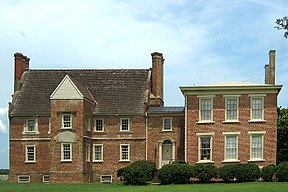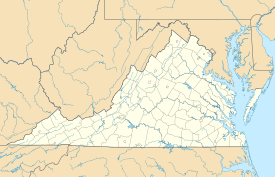Bacon's Castle
| Bacon's Castle | ||
|---|---|---|
| National Register of Historic Places | ||
| National Historic Landmark | ||
|
The house in 2006 |
||
|
|
||
| location | Surry County , Virginia , United States | |
| Coordinates | 37 ° 6 '32.5 " N , 76 ° 43' 20.6" W | |
| Built | 1665 | |
| Architectural style | Jacobean , Greek Revival | |
| NRHP number | 66000849 | |
| Data | ||
| The NRHP added | October 15, 1966 | |
| Declared as an NHL | October 9, 1960 | |
Bacon's Castle , also Allen's Brick House or Arthur Allen House , is a mansion in Surry County in the US state of Virginia . It is documented as the oldest brick house in Virginia. The house, completed in 1665, is considered one of the particularly rare examples of Jacobean architecture in the New World .
The house came to be known as Bacon's Castle because it was occupied as a fort or castle by the followers of Nathaniel Bacon during Bacon's rebellion in 1676. Contrary to popular rumors, Bacon himself neither lived in Bacon's Castle, nor is it known that he ever visited it.
Today Bacon's Castle is a historic house and museum that is open to the public. It has been a National Historic Landmark since October 1960 and has been listed as a structure on the National Register of Historic Places since October 1966 .
history
Soon after Surry County was designated in the British colony of Virginia in 1652, Arthur Allen built a brick Jacobean style house on the James River in 1665 , where he and his wife Alice (née Tucker ) lived. Allen was a rich merchant and justice of the peace . He died in 1669, but his son, Major Arthur Allen II , inherited the house and estate. Major Allen was a member of the Virginia House of Burgessess (legislative assembly).
Around mid-September 1676, a number of followers of the "Frontiersman" (settlers and fighters against the Indians) Nathaniel Bacon seized the brick house and fortified it. The garrison , alternately commanded by William Rookings , Arthur Long , Joseph Rogers, and John Clements , held the house under their control for over three months while their skins swam away. Bacon's death in October left his troops under the command of Joseph Ingram , who, however, was not up to the task. Ingram divided his army into small garrisons. As the demoralized troops began indiscriminate looting, the colony's condition soon became deplorable.
Royal Governor Sir William Berkeley captured the isolated loopholes one by one, some by force, others by persuasion. On December 29, loyal troops aboard the ship Young Prince captured an unspecified fort that many historians identified as Bacon's Castle. After a brief siege in January 1677, the Loyalists used the "fort" as a base of operations for the final skirmishes of the rebellion, which ended before the end of that month.
Bacon was the owner of Curles Neck Plantation , a tobacco plantation in Henrico County , about 50 kilometers upstream on the north bank of the James River. Many historians believe that Bacon's Castle was not used again until many years after the end of Bacon's Rebellion. In 1769 the Virginia Gazette , a newspaper in the capital city of Williamsburg , used this name in publishing various articles about Bacon's rebellion.
Preservation and current operation
In the 1970s, Preservation Virginia (formerly: Association for the Preservation of Virginia Antiques ) acquired Bacon's Castle and renovated it. The renovation work will continue despite visitor traffic. Bacon's Castle is now a museum and historical landmark. The property has 16 hectares and, in addition to the manor house itself, houses a number of outbuildings, such as B. barns, slave and tenant shelters and smokehouse. There is a rare, formal 17th century English garden on the grounds. Visitors can visit the outbuildings and gardens all year round without a guide. The manor house can be visited from March to November. There is also a souvenir shop there . Guided group tours are available by appointment.
architecture
Bacon's Castle is a rare example of Jacobean architecture in the United States and the only 17th century mansion there to this day. It is one of only three surviving mansions of this architectural style in the western hemisphere. The other two are in Barbados ( Drax Hall Estate and St Nicholas Abbey ). Notable architectural details are e.g. As the three spacious fireplaces that shaped volute and the carved wind roses on the cross girders in many public places.
Several changes were made to Bacon's Castle in the mid to late 19th century. An originally one-story wing for the servants was replaced by a higher Greek Revival wing . Around this time, the entrance from the middle of the main building was moved to the intermediate wing between the original house and the annex, and the box windows with the diamond-shaped panes were replaced with double-hung sliding windows. Moving the front door to the left left an empty space in the bay window of the original house, which was filled with a window. All of these changes were preserved during the restoration.
Individual evidence
- ^ Preserving Virginia. 1889–1989: Centennial Pictoral . The Art Band, Virginia 1989, p. 121.
- ↑ a b c d Bacon's Castle in National Register of Historic Places Nomination Form. P. 2.
-
↑ Listing of National Historic Landmarks by State: Virginia. National Park Service , accessed February 27, 2020.
Bacon's Castle on the National Register of Historic Places , accessed February 27, 2020. - ↑ Bacon's Castle. Preservation Virginia, archived from the original on July 17, 2010 ; accessed on January 29, 2015 .
- ^ Virginia McAlester: A Field Guide to American Houses . Alfred A. Knopf, New York 1984, ISBN 0-394-73969-8 , p. 110.
- ^ Jeffery Howe, The Houses We Live In: An Identification Guide to the History and Style of American Domestic Architecture . PRC Publishing, London 2002, ISBN 1-85648-637-0 , pp. 125-126.
literature
- Thomas J.wertebaker: Virginia under the Stuarts 1607–1688 . Princeton University, New Jersey 1914.
- Hugh Morrison: Early American Architecture . New York 1952.
- Fiske Kimball: Domestic Architecture of the American Colonies and of the Early Republic . New York 1922.
Web links
- Bacon's Castle at preservationvirginia.org
- Bacon's Castle, State Route 617, Surry, Surry County, VA . Library of Congress : 46 photos, 3 colored transparencies, 22 drawings, 8 data pages and 2 photo pages




